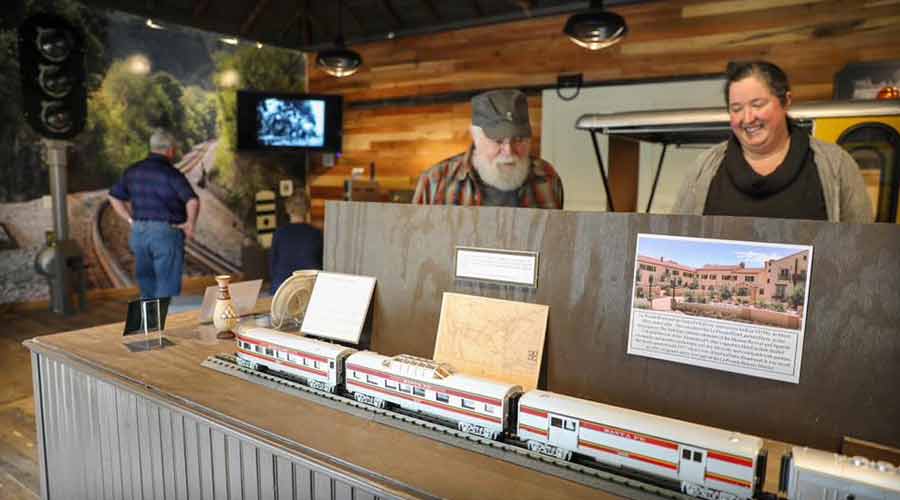Tennessee museum exhibit tells story of women, African American railroaders
4/12/2023
By Grace Renderman, Associate Editor
Erwin, Tennessee, native resident Millie Longcrier started her 15-year railroading career on the Carolina, Clinchfield and Ohio Railway, and ended it with CSX.
Longcrier’s brother worked as a conductor for Norfolk Southern Railway, and her grandfathers and uncles were locomotive engineers. Longcrier wanted to be a clerk or dispatcher (a “crew caller” back then), working an office job rather than in the field. She applied for jobs on the Carolina, Clinchfield and Ohio multiple times between 1977 and 1979, but never heard back.
Then, in 1980, she got the call to join the railroad — as a brakeman, a job uncommon for women to hold at the time. She also would occasionally serve as a conductor.
“My family encouraged me to do it, and they said you can get in there and get your foot in the door, and then maybe change craft,” Longcrier says.
She never did. Longcrier was hired along with nine others for the dual brakeman/conductor position that year. While most of her colleagues on the Clinchfield were men, there were a few other women there on the 150-mile stretch of track running between Spartanburg, South Carolina, and Shelby, Kentucky.
 The new exhibit — “Our Work, Our Stories: African Americans, Women and the Railroad” — highlights the inventions and other contributions of Black and women railroaders to the rail industry. Chuckey Depot Museum/Facebook
The new exhibit — “Our Work, Our Stories: African Americans, Women and the Railroad” — highlights the inventions and other contributions of Black and women railroaders to the rail industry. Chuckey Depot Museum/FacebookLongcrier retired from the railroad in 1995, which by that time had been bought by the Seaboard System Railroad, a CSX predecessor.
On March 11, Longcrier told her story to the 40 or so who attended the opening of a new exhibit honoring the contributions of female and Black railroaders to the industry at the Chuckey Depot Museum located in Jonesborough, Tennessee.
The exhibit — “Our Work, Our Stories: African Americans, Women and the Railroad” — is on display until September.
The exhibit features historical artifacts, and information on game-changing inventions and the people who made them, says Anne Mason, a member of the museum’s advisory board.
Mason also is executive director of the Heritage Alliance of Northeast Tennessee and Southwest Virginia, which helped create the exhibit and purchase artifacts for display. The Jonesborough nonprofit organization is “dedicated to the preservation of the architectural, historical and cultural heritage” of the region, mostly through museums, according to the organization’s website.
“We wanted to do a temporary exhibit that shares the history of African Americans and women on the railroad. Those are stories you don't hear very often, or they're not highlighted,” Mason says. “So, we started digging in and doing the research [on] … whose inventions completely changed the railroad.”
From drip cups to hotels
Some of the inventions on display include the oil-drip cup for steam engine self-lubrication, created by Black Canadian-American brakeman Elijah McCoy. The invention would prevent the need for steam engines to periodically be stopped to be lubricated. In 1872, McCoy filed a U.S. patent for the automatic lubricator system.
That invention would later spawn the expression “the real McCoy” because customers wanted to make sure they were buying the real thing and not a knock-off product, Mason says.
The exhibit shines a spotlight on the famous "Pullman Porters,” who worked for the Pullman Co. Most of the porters, hired to work on passenger-rail sleeper cars shortly after the American Civil War’s end, were former slaves. The men worked for Pullman until it ceased operations in 1968.
 The Heritage Alliance of Northeast Tennessee and Southwest Virginia helped create the exhibit, which is open until September. Putting together the exhibit involved buying artifacts from eBay. Chuckey Depot Museum/Facebook
The Heritage Alliance of Northeast Tennessee and Southwest Virginia helped create the exhibit, which is open until September. Putting together the exhibit involved buying artifacts from eBay. Chuckey Depot Museum/FacebookThe same men formed the first African American labor union in the United States, the Brotherhood of Sleeping Car Porters, which reached a collective bargaining agreement with the company in 1937.
Then there’s Mary Colter, an architect who helped design and build the hotels in which on-call railroaders working for the then-Atchison, Topeka and Santa Fe Railroad rested at the turn of the 20th century. Most of those hotels are still standing, Mason says.
“A lot of the women inventors we found either worked for the Baltimore and Ohio Railroad or the Santa Fe line,” she says.
Behind the scenes
The museum’s exhibit design committee took about six months to research the materials and information needed to build the exhibit, Mason says. The committee collected 10 to 20 artifacts ranging from brochures to pins to Pullman porter passes to items from World War II.
The committee purchased most of the items on eBay.
“We found some really great stuff for very little money,” Mason says.
The Watauga Valley Railroad Historical Society, which is headquartered at the Chuckey Depot Museum, owns many railroad-related artifacts that are often on loan to the museum. But Watauga didn’t have much that fit this exhibit’s theme, Mason says.
“We actually — for the first time — had to go out and purchase artifacts, which was exciting because we got to create this educational collection,” she says. “Once they come off display at the Chuckey Depot, [the Heritage Alliance is] going to add them to our educational collection.”
All the materials help drive home the point that women and Black railroaders made monumental contributions to the railroad industry, Mason says.
Longcrier believes she contributed to the railroad by opening the eyes of young girls hoping to get industry experience.
“There’s no reason a female cannot work on the railroad,” Longcrier says. “It’s a good job, benefits and all, so why would you not want to?”


